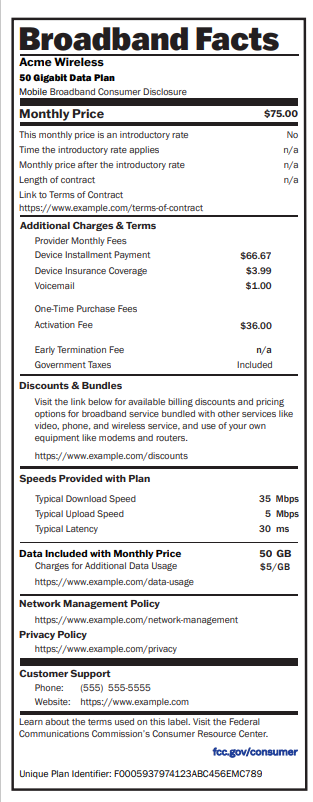UPDATE Most ISPs offering standalone broadband internet service will be required to display consumer-friendly labels at the point of sale – including in-store and online – as of today. The labels are similar to nutrition labels on food products. According to FCC rules, the labels must display key information consumers want such as prices, speeds, fees, data allowances, and other critical information. They must also include links to learn more about available discounts or service bundles, network management practices and privacy policies.
To ensure the labels benefit everyone, the Commission adopted language and accessibility requirements for display. Labels are required for all standalone home or fixed internet service or mobile broadband plans. The details for each plan “cannot be buried under multiple clicks,” an FCC official told reporters. Providers must display the label – not simply an icon or link to the label – close to an associated plan’s advertisement.
The labels are part of President Biden’s plan to get families more breathing room in their budgets, according to Jon Donenberg, Deputy Director, White House National Economic Council. The point of the labels is to make sure prices are clear and transparent to consumers, as well as “rooting out junk fees some companies use to raise costs. Obscuring fees in fine print makes it harder to find the true cost and makes it hard to comparison shop,” Donenberg told reporters. “We know for many consumers this lack of upfront transparency means their monthly bill can be much higher than they thought it would be.”
Making sure everyone has clear, straightforward pricing information will help consumers save money, according to the White House official. It also means companies can compete on even terms, he said. “This is President Biden’s overall plan to make sure everyone can get affordable internet,” said Donenberg.
Related to this topic is the status of the FCC’s Affordable Connectivity (ACP) plan. The Commission and the White House say 23 million households rely on the ACP for lower internet costs. Those households include military families and one-quarter are seniors. Donenberg said the President is calling on Congress once again to refund the ACP through 2024. Without more money, the program will end in May, Inside Towers reported.
The new labels have been in the works for years. The FCC first sought advice on the labels in 2015. In November 2021, Congress passed the bipartisan Infrastructure Law, which directed the FCC to require consumer-friendly labels with information about broadband services.
In 2022, the FCC adopted the new rules, Inside Towers reported. At the time, some ISPs said they were onerous. Comcast and petitioners Verizon, AT&T and other groups said the FCC underestimated the work involved in implementing them.
The Wireless Internet Service Providers Association WISPA VP Policy Louis Peraertz said at the time the label would help consumers to quickly “see under the hood,” and allow for an effective apples-to-apples comparison tool when shopping for services in the marketplace.
“When we established these rules we gave large and small providers the necessary runway to implement the labels,” said a senior FCC official. “We saw in 2016 some were ready. Since [2022], we’ve been seeing labels pop up.”
By this October, ISPs must make the labels machine-readable so third parties can more easily collect and aggregate data to create comparison-shopping tools for consumers. Providers with less than 100,000 subscribers must also comply with the rules, though there are some exceptions for them on the implementation timeline, according to an FCC spokesperson.
By Leslie Stimson, Inside Towers Washington Bureau Chief





Reader Interactions